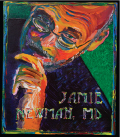The little brown bottle
The first documented recommendation of nitroglycerin for angina pectoris was described by Dr. William Murrell in 1877.
“A 64-year-old white male came under observation in December…, complaining of intense chest pain, precipitated by the slightest exertion. The pain came on quite suddenly while walking and was accompanied by shortness of breath. From his chest, the pain flies to the inner side of the left arm at a point midway between the shoulder and elbow. His first of such attacks was a year ago in May. The attacks had been increasing in frequency the past couple of months and had been a source of constant anxiety. The patient had noticed that he often got them walking up hills or with particular exertion after a heavy meal. Stooping down and pulling on his work boots had also initiated similar episodes of pain.”
This probably sounds like many patients you have admitted. But where are the EKG findings, the vital signs? Does the patient have angina or a STEMI? It's hard to know, as this case description was written in 1877. Willem Einthoven, the inventor of the EKG, was only 17 at the time.

But suppose the details were thus: The patient had a 25 pack-year history of cigarette smoking and drank 2 glasses of whiskey per day. Physical examination showed no remarkable abnormalities. His blood pressure, controlled with losartan and lovastatin, was 130/75 mm Hg; respirations were 12 per minute; and pulse was regular at 72 beats per minute. His resting EKG suggested an old inferior wall infarct and his troponins were normal.
To almost all physicians, the appropriate therapy is obvious: a drug traditionally stored in a little brown bottle that can be taken prophylactically or as needed for rapid relief of angina pectoris—nitroglycerin.
The first documented recommendation of this remedy for angina pectoris was described by Dr. William Murrell in 1877. Dr. Murrell was an esteemed lecturer on practical physiology at Westminster Hospital, a practitioner at the Royal Hospital for Disease of the Chest, and a member of the faculty of medicine of the University of London. At a time when most leading physicians believed that understanding the physiologic or the pharmaceutic action of drugs was menial work, appropriate for community physicians, Dr. Murrell found himself under the influence of British physiologist Sydney Ringer, who likely led Dr. Murrell to experiment with the drug.
Dr. Murrell first described his findings in an 1879 manuscript in The Lancet. He introduced nitroglycerin to his peers by reviewing the experiences of his superiors 20 years prior, who had argued about which dosage provided the most beneficial effects. The debate justified his self-experimentation with the drug, which he was so eager to undertake, he ill-advisedly began it while seeing patients. He touched a cork stopper soaked with the liquid drug to his tongue. Dr. Murrell explained that, within minutes, “the pulsation rapidly increased, and soon became so severe that each beat of the heart seemed to shake my whole body.” Attempting to auscultate his patient “caused such an intense beating in my head that it was almost unbearable.” Lacking the measurement technology that we have today, he estimated the amount of pulsation “by holding a looking glass in the hand and throwing the reflection into a dark corner of the room.” Knowing that previous experimenters had varying responses to the drug, he administered it to 35 others: 12 males and 23 females, ages 12 to 58 years. They experienced symptoms similar to those of Dr. Murrell: tachycardia associated with a pounding headache and an increase in the force of the heartbeat.
Because Dr. Murrell was an expert on physiologic response to pharmaceuticals, it was clear to him that this drug could be useful in alleviating angina pectoris, but first, he wished to compare its effects with those of nitrite of amyl, using sphygmographic tracings. At the time, the sphygmograph was the latest technology to measure blood pressure and record pulsations. Dr. Murrell found the effects of the drug to be superior to that of nitrite of amyl, noting that it was “more lasting in its power of producing a dicrotic form of pulse beat, and consequently in cases where the conditions of relaxation and dicrotism are desired to be maintained for a space of time, its exhibition is to be preferred.” His first patient was that 64-year-old man previously described. Dr. Murrell prescribed 1% solution 3 times a day, and the patient reported significant improvement, with reduced frequency and severity of attacks. In fact, the patient found that a dose taken during an attack shortened its duration considerably. The patient made it a habit to carry the medicine with him in case an attack seized him in public, and “it never failed to afford relief.”
Although the current tablet preparation of nitroglycerin differs from the liquid Dr. Murrell prescribed, its use has traversed the years largely unchanged. By primarily causing venous dilation, nitroglycerin decreases ventricular preload, reducing oxygen demand on the heart, and thereby improves the oxygen supply/demand ratio. The reduction in preload also has coronary effects, as the decreased diastolic wall stress improves subendocardial perfusion and oxygen delivery. In addition, some systemic arterial dilation occurs, and, thus, nitroglycerin plays a minor role in reducing afterload, further enhancing cardiac output and improving the oxygen supply/demand ratio.
Dr. Murrell's report in The Lancet also made clear the side effects: hypotension-induced reflex tachycardia and headache due to cerebral vasodilation. Nitroglycerin's physiologic effects make it the drug of choice for those experiencing angina pectoris due to coronary artery disease, coronary vasospasm, or myocardial infarction, hence its widespread utilization for over 130 years.



